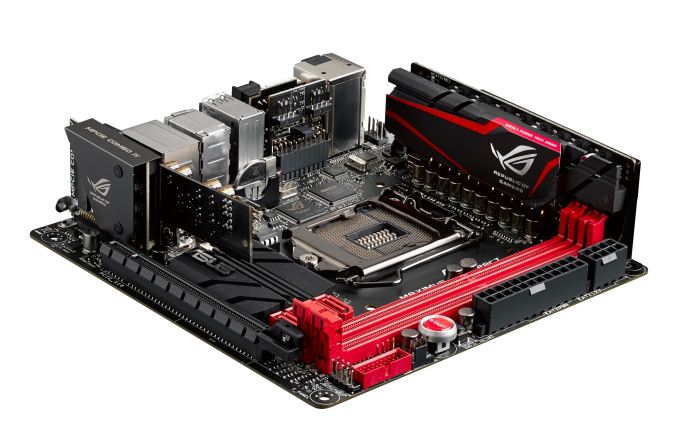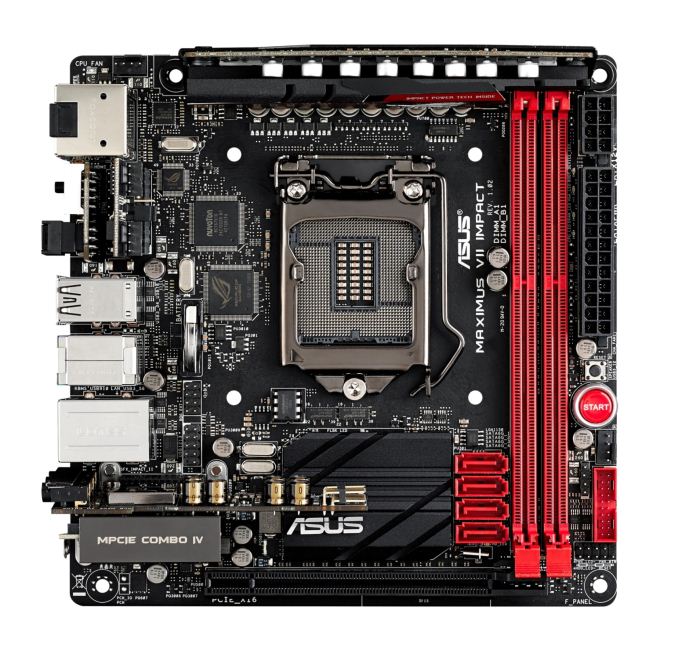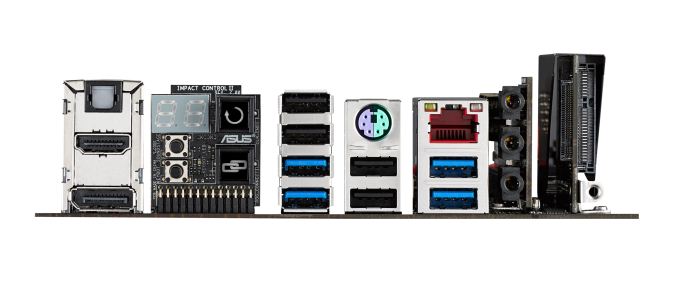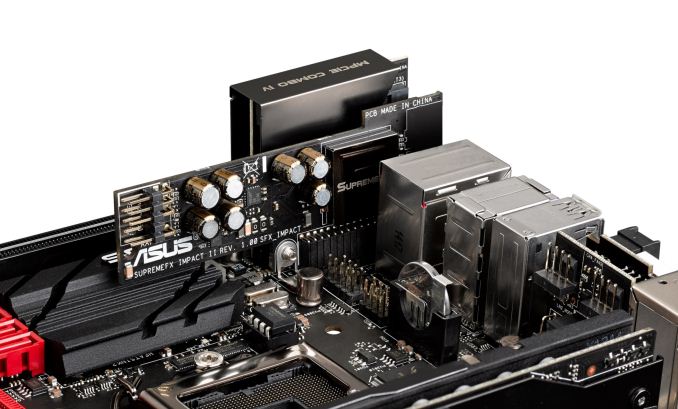ASUS ROG Z97 Maximus VII Impact Officially Launched
by Ian Cutress on August 14, 2014 4:25 AM EST- Posted in
- Motherboards
- Intel
- Asus
- ROG
- Z97

One of the highlights of ASUS’ ROG Computex Press Event was the announcement of the Maximus VII Impact, the successor to the popular mini-ITX ROG Impact range of motherboards. Today the motherboard is officially released from ASUS HQ, with stock coming to regions shortly. We reviewed the Maximus VI Impact last year and was appropriately impressed by the effort to include so many features in the mini-ITX platform – ASUS is hoping that this Z97 upgrade kicks it up a notch.
Similar to the Maximus VI, the order of the day is extra PCBs in order to add features. The power delivery is upgraded to the ROG 9-series design, and the audio add-on SupremeFX card moves up with fewer filter caps in a more optimized output. The mPCIe Combo moves up to revision four which includes a PCIe 3.0 x4 M.2 slot and a mini-PCIe slot with a bundled 802.11ac dual band WiFi module. Note that when the M.2 slot is occupied, the PCIe slot will reduce to PCIe 3.0 x8, although our previous testing of a similar feature shows no frame rate difference at 1080p.
The Impact Control on the rear panel uses the same two-digit debug as the previous version, along with ROG Connect and a Clear CMOS button, but the two buttons included are for the KeyBot and SoundStage functionality introduced with the Maximus VII range. KeyBot is a feature to enable macros with any keyboard with the ASUS software, and SoundStage acts as a configurable op-amp that modifies various aspects of the audio output to be more suited for various styles of gaming.
Interestingly enough the rear of the Impact Control is another PCB, holding two 4-pin fan headers to compliment the 4-pin CPU fan header on the top left and the chassis header on the right of the motherboard. Also of note is the rear panel, where a single block of USB ports uses two USB 3.0 ports and two USB 2.0 ports – this configuration I have not seen on a motherboard before and could pave the way for something on most motherboards for the future.
The DRAM slots use single side latches on the power delivery side, and the power connectors are gladly on the outsides of the motherboard. This follows the start button, a fan header and a USB 3.0 header. The front panel header is also on the right side of the DRAM slots. The SATA 6 Gbps ports are unfortunately just inside the DRAM slots and all in the same direction, perhaps causing issues with trying to remove locking cables.
The socket area is up against Intel specifications, suggesting that CPU coolers might be up against the power delivery or tall memory modules. The audio is buffeted by Sonic Rader II, an onscreen representation of directional audio, and networking comes via the 802.11ac WiFi and an Intel I218-V with GameFirst III.
We are awaiting information from ASUS’ US office for pricing and availability.













26 Comments
View All Comments
SirKnobsworth - Thursday, August 14, 2014 - link
I'm curious why they would route the 4 M.2 PCIe lanes from the CPU rather than use the abundant lanes on the PCH (there are 6 open lanes as it stands). It might give a slight performance boost to the SSD but it still seems like an odd choice.Smuggy - Thursday, August 14, 2014 - link
Yeah, I was a little confused by the laning, so the comment "Note that when the M.2 slot is occupied, the PCIe slot will reduce to PCIe 3.0 x8" means that the M.2 is connecting to the CPU directly, right? So the other lanes are used up by, the wifi module which can't be disabled to free up the lanes? Or something else entirely...dakishimesan - Thursday, August 14, 2014 - link
The PCH only supplies PCIe gen 2 lanes. Only the CPU supplies gen 3. Not sure if gen 3 is absolutely necessary for ssd though.dakishimesan - Thursday, August 14, 2014 - link
http://www.intel.com/content/www/us/en/chipsets/pe...dakishimesan - Thursday, August 14, 2014 - link
for reference:PCIe gen1 x4 = 1000MB/s
gen2 x4 = 2000
gen3 x4 = 4000MB/s ... overkill. possibly. those new Intel PCIe SSD's can hit ~1500MB/s burst, still well within gen2 x4, for now.
Kevin G - Thursday, August 14, 2014 - link
The key word is 'for now'. It wouldn't surprise me if the next generation of SSD controllers would be able to go beyond 2000 MB/s and thus making PCIe 3.0 a requirement to do so.JeremyAU - Friday, August 15, 2014 - link
Yes, 3D NAND is here and now. SATA won't have enough bandwidth to cope with the next gen of SSDs, hence M.2 PCIe and SATA Express specifications.JeremyAU - Friday, August 15, 2014 - link
As PCIe is considered a 'serial' interface shouldn't those measurements be Mbits, not MBytes? Huge difference in throughput.SirKnobsworth - Thursday, August 14, 2014 - link
The wired and wireless networking are run off the PCH, which has 8 PCIe 2.0 lanes.Morawka - Thursday, August 14, 2014 - link
I applaud Asus for the M.2 Lane Choices. This board is only going to have 1 GPU obviously, and last gen they had M.2 on a 2X bus. This is the fastest M.2 implementation on the market currently.It all makes sense when you consider this is a mini itx board that will have AT MOST, 1 GPU, and even a Titan will not be hampered by 8X PCIE 3.0